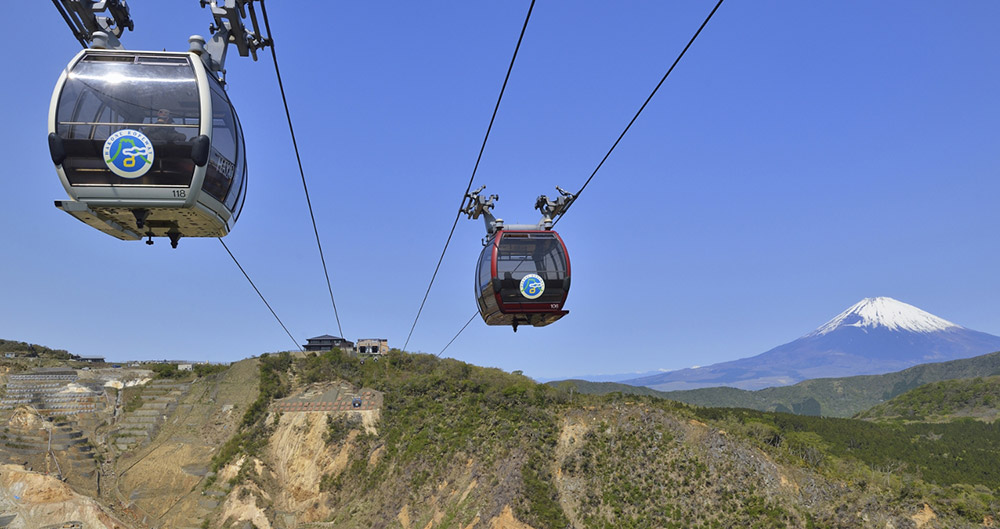Introduction
The Hakone Ropeway (箱根ロ-プウエイ) offers an unparalleled way to experience the majestic natural beauty of Hakone. This 4-kilometer aerial lift connects Sounzan Station to Togendai Station, passing through Owakudani and Ubako stations, providing visitors with a unique vantage point to admire Hakone’s mountains, lakes, and volcanic landscapes.
Key Information
- Total journey time: approximately 30 minutes
- Connects Sounzan Station and Togendai Station
- Stops at Owakudani and Ubako stations
- Offers views of Owakudani, Lake Ashinoko, and Mount Fuji
- Fully covered by the Hakone Free Pass
Historical Background
The Hakone Ropeway opened in 1959, initially to improve transportation in the Hakone area. Over the years, it has evolved from a mere transportation tool to a popular tourist attraction. The cable car system has undergone several upgrades and renovations. Today’s gondolas can accommodate about 10 people each and depart every minute, greatly improving capacity and comfort.
Main Attractions
Owakudani: A Spectacular Display of Volcanic Activity
Owakudani is one of the most striking attractions along the Hakone Ropeway. This active volcanic valley is dotted with sulfuric hot spring vents. From the ropeway, you can see white steam rising from the bare gray slopes, creating a breathtaking volcanic landscape. Owakudani Station serves as a transfer point where visitors can disembark to explore. The station features observation decks for close-up views of the sulfur vents and a chance to try the famous black eggs – chicken eggs cooked in the sulfuric hot springs, said to add seven years to your life if eaten. The Owakudani area also offers several hiking trails for those who wish to experience this unique volcanic terrain more intimately.
Lake Ashinoko: Hakone’s Iconic Landscape
After leaving Owakudani Station, the ropeway begins its descent towards Togendai Station. On clear days, this stretch offers the opportunity to admire one of Hakone’s most famous landscapes – Lake Ashinoko. This caldera lake, formed by a volcanic eruption, is surrounded by lush green mountains and often reflects the sky and clouds on its surface, creating a stunning natural tableau. The ropeway’s panoramic windows provide an excellent viewing experience, making passengers feel as if they’re in an airborne art gallery. Lake Ashinoko is not just a sight to behold but also a haven for various water activities such as boat cruises and kayaking, which visitors can explore further upon reaching Togendai Station.
Mount Fuji: Japan’s Iconic Symbol
Perhaps the most anticipated view during the Hakone Ropeway journey is that of Mount Fuji. On clear days, passengers can glimpse Japan’s highest peak from the ropeway. Mount Fuji’s perfect conical shape rises in the distance, often shrouded in a light mist, presenting a mysterious and majestic beauty. This view is particularly stunning in winter when Fuji’s peak is capped with snow. While the visibility of Mount Fuji depends on weather conditions, catching a glimpse of it is sure to be a memorable experience. Ropeway staff usually alert passengers to the best viewing positions to ensure you don’t miss this rare sight.
Best Time to Visit
- Spring (late March to May): Cherry blossoms in bloom, beautiful scenery
- Autumn (October to November): Fall foliage season, vibrant colors
- Winter (December to February): Possible snow scenes and snow-capped Mount Fuji
- Early morning or late afternoon: Fewer crowds and chances to see sunrise or sunset
Transportation Guide
- From Shinjuku Station:
- Take the Odakyu Romance Car to Hakone-Yumoto Station (about 85 minutes)
- Transfer to the Hakone Tozan Railway to Gora Station (about 40 minutes)
- From Gora Station, take the Hakone Tozan Cable Car to Sounzan Station (about 10 minutes)
- From Tokyo Station:
- Take the Shinkansen to Odawara Station (about 35 minutes)
- Transfer to the Hakone Tozan Railway to Gora Station (about 50 minutes)
- From Gora Station, take the Hakone Tozan Cable Car to Sounzan Station (about 10 minutes)
Opening Hours and Ticket Information
- Operating hours: 9:00 – 16:45 (until 16:15 in December and January)
- Ticket prices:
- One-way: 1,500 yen
- Round-trip: 2,500 yen
- Fully covered by the Hakone Free Pass
Visitor Tips and Advice
- Purchase the Hakone Free Pass to save money and easily use multiple modes of transportation
- Bring warm clothing as temperatures can be cooler at higher altitudes
- Choose a clear day for the best views
- Be aware of the sulfur smell at Owakudani Station; those sensitive to odors may want to bring a mask
- Check the weather forecast in advance and choose a day with good visibility
- Don’t miss trying the famous black eggs at Owakudani
- At Togendai Station, consider continuing your journey with a boat cruise on Lake Ashinoko
Official Website
Conclusion
The Hakone Ropeway is not just a convenient mode of transport connecting Hakone’s major attractions; it’s a unique aerial sightseeing experience. From volcanic landscapes to scenic lakes and mountains, and possibly views of Mount Fuji, this 30-minute journey encapsulates the essence of Hakone. Whether you’re a nature enthusiast, a photography buff, or simply a traveler looking for a relaxing experience, the Hakone Ropeway promises unforgettable memories. Are you ready? Let’s embark on this aerial adventure through Hakone!
